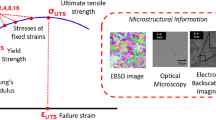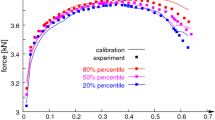Abstract
This study examines the link between microstructure and mechanical properties of additively manufactured metal parts by developing a predictive model that can estimate properties such as ultimate tensile strength, yield strength, and elongation at fracture based upon microstructural data for 17-4 PH stainless steel. The main benefit of the approach presented is the generalizability, as necessary testing is further reduced in comparison with similar methods that generate full process–structure–property linkages. Data were collected from the available literature on AM-built 17-4 PH stainless steel, in-house tensile testing and imaging, and testing conducted by an AM company. After standardizing the image size and grain boundary extraction via image processing, the features such as grain size distributions and aspect ratios were extracted. By using artificial neural networks, relationships were established between grain size and shape features and corresponding mechanical properties, and subsequently, properties were predicted for novel samples to which the network had not previously been exposed. The model produced correlation coefficients of R2 = 0.957 for ultimate tensile strength, R2 = 0.939 for yield strength, and R2 = 0.931 for fracture elongation. These results demonstrate the efficacy of predictive models that focus upon microstructure–property relationships and highlight an opportunity for further exploration as predictive modeling of metal additive manufacturing continues to improve.














Similar content being viewed by others
References
Tenner J, Linkens DA, Morris PF, Bailey TJ (2001) Prediction of mechanical properties in steel heat treatment process using neural networks. Ironmak Steelmak 28(1):15–22. https://doi.org/10.1179/irs.2001.28.1.15
Sterjovski Z, Nolan D, Carpenter KR, Dunne DP, Norrish J (2005) Artificial neural networks for modelling the mechanical properties of steels in various applications. J Mater Process Technol 170(3):536–544. https://doi.org/10.1016/j.jmatprotec.2005.05.040
DebRoy T, Mukherjee T, Wei HL, Elmer JW, Milewski JO (2020) Metallurgy, mechanistic models and machine learning in metal printing. Nat Rev Mater 6(1):48–68. https://doi.org/10.1038/s41578-020-00236-1
Popova E, Rodgers TM, Gong X, Cecen A, Madison JD, Kalidindi SR (2017) Process-structure linkages using a data science approach: application to simulated additive manufacturing data. Integr Mater Manuf Innov 6(1):54–68. https://doi.org/10.1007/s40192-017-0088-1
Herriot C, Spear AD (2020) Predicting microstructure-dependent mechanical properties in additively manufactured metals with machine- and deep-learning methods. Comput Mater Sci. https://doi.org/10.1016/j.commatsci.2020.109599
Wan HY, Chen GF, Li CP, Qi XB, Zhang GP (2019) Data-driven evaluation of fatigue performance of additive manufactured parts using miniature specimens. J Mater Sci Technol 35(6):1137–1146. https://doi.org/10.1016/j.jmst.2018.12.011
Yang Z, Yu C-H, Buehler MJ (2021) Deep learning model to predict complex stress and strain fields in hierarchical composites. Sci Adv. https://doi.org/10.1126/sciadv.abd7416
Bayraktar Ö, Uzun G, Çakiroğlu R, Guldas A (2017) Experimental study on the 3D-printed plastic parts and predicting the mechanical properties using artificial neural networks. Polym Adv Technol 28(8):1044–1051. https://doi.org/10.1002/pat.3960
Xie X, Bennett J, Saha S, Lu Y, Cao J, Liu WK, Gan Z (2021) Mechanistic data-driven prediction of as-built mechanical properties in metal additive manufacturing. npj Comput Mater. https://doi.org/10.1038/s41524-021-00555-z
Lu L, Dao M, Kumar P, Ramamurty U, Karniadakis GE, Suresh S (2020) Extraction of mechanical properties of materials through deep learning from instrumented indentation. Proc Natl Acad Sci 117(13):7052–7062. https://doi.org/10.1073/pnas.1922210117
Yan W, Lian Y, Yu C, Kafka OL, Liu Z, Liu WK, Wagner GJ (2018) An integrated process–structure–property modeling framework for additive manufacturing. Comput Methods Appl Mech Eng 339(1):184–204. https://doi.org/10.1016/j.cma.2018.05.004
Gao W, Zhang Y, Ramanujan D, Ramani K, Chen Y, Williams CB, Wang CCL, Shin YC, Zhang S, Zavattieri PD (2015) The status, challenges, and future of additive manufacturing in engineering. Comput-Aided Des 69(1):65–89. https://doi.org/10.1016/j.cad.2015.04.001
Yadollahi A, Shamsaei N, Thompson SM, Elwany A, Bian L (2015) mechanical and microstructural properties of selective laser melted 17-4 PH stainless steel. In: Proceedings of the ASME 2015 international mechanical engineering congress and exposition, 2A(1). https://doi.org/10.1115/imece2015-52362
Rafi HK, Pal D, Patil N, Starr TL, Stucker BE (2014) Microstructure and mechanical behavior of 17-4 precipitation hardenable steel processed by selective laser melting. J Mater Eng Perform 23(12):4421–4428. https://doi.org/10.1007/s11665-014-1226-y
Yadollahi A, Mahmoudi M, Elwany A, Doude H, Bian L, Newman JC (2020) Effects of crack orientation and heat treatment on fatigue-crack-growth behavior of AM 17-4 PH stainless steel. Eng Fract Mech. https://doi.org/10.1016/j.engfracmech.2020.106874
Pasebani S, Ghayoor M, Badwe S, Irrinki H, Atre SV (2018) Effects of atomizing media and post processing on mechanical properties of 17-4 PH stainless steel manufactured via selective laser melting. Addit Manuf 22(1):127–137. https://doi.org/10.1016/j.addma.2018.05.011
Hsu TH, Chang YJ, Huang CY, Yen HW, Chen CP, Jen KK, Yeh AC (2019) Microstructure and property of a selective laser melting process induced oxide dispersion strengthened 17-4 PH stainless steel. J Alloy Compd 803(1):30–41. https://doi.org/10.1016/j.jallcom.2019.06.289
Mahmoudi M, Elwany A, Yadollahi A, Thompson SM, Bian L, Shamsaei N (2017) Mechanical properties and microstructural characterization of selective laser melted 17-4 PH stainless steel. Rapid Prototyp J 23(2):280–294. https://doi.org/10.1108/rpj-12-2015-0192
Alnajjar M, Christien F, Bosch C, Wolski K (2020) A comparative study of microstructure and hydrogen embrittlement of selective laser melted and wrought 17–4 PH stainless steel. Mater Sci Eng A. https://doi.org/10.1016/j.msea.2020.139363
Yadollahi A, Shamsaei N, Thompson SM, Elwany A, Bian L (2017) Effects of building orientation and heat treatment on fatigue behavior of selective laser melted 17–4 PH stainless steel. Int J Fatigue 94(1):218–235. https://doi.org/10.1016/j.ijfatigue.2016.03.014
Wang X, Liu Y, Shi T, Wang Y (2020) Strain rate dependence of mechanical property in a selective laser melted 17–4 PH stainless steel with different states. Mater Sci Eng A. https://doi.org/10.1016/j.msea.2020.139776
Callister WD (2000) Fundamentals of materials science and engineering, vol 471660817. Wiley, London
Raeisinia B, Poole WJ (2011) Modelling the elastic–plastic transition of polycrystalline metals with a distribution of grain sizes. Modell Simul Mater Sci Eng 20(1):015015. https://doi.org/10.1088/0965-0393/20/1/015015
Kumar IE, Venkatasubramanian S, Scheidegger C, Friedler S (2020) Problems with Shapley-value-based explanations as feature importance measures. In: International conference on machine learning. PMLR, pp 5491–5500
Acknowledgements
The authors gratefully acknowledge the tensile specimens and microstructural images provided by the Digital Metals and Innovative 3D Manufacturing during this study. During this study, all the experimental work was supported by the Donald A. & Nancy G. Roach Professorship at Purdue University.
Author information
Authors and Affiliations
Corresponding author
Ethics declarations
Conflict of interest
The authors have no conflict of interest.
Rights and permissions
About this article
Cite this article
Porro, M., Zhang, B., Parmar, A. et al. Data-Driven Modeling of Mechanical Properties for 17-4 PH Stainless Steel Built by Additive Manufacturing. Integr Mater Manuf Innov 11, 241–255 (2022). https://doi.org/10.1007/s40192-022-00261-8
Received:
Accepted:
Published:
Issue Date:
DOI: https://doi.org/10.1007/s40192-022-00261-8




